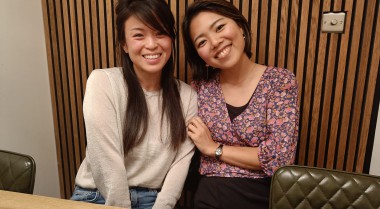What are Peace Games? A hands-on approach explained
It was late at night in November 2024 when Salissou from Niger and Henrietta from Cameroon first crossed paths at Entebbe Airport in Uganda. Both young peacebuilders were drawn to a big, bold sign in a metal frame that read "GPPAC/CECORE," signalling their shared destination. Little did they know, they had been on the same flight from Addis Ababa, en route to the informal regional consultation of the 2025 UN Peacebuilding Architecture Review (PBAR) organised by our Regional Secretariat for Eastern and Central Africa, CECORE.
Ask them about their first encounter, and their faces light up with knowing smiles. “She’s inspiring,” Salissou says warmly, and it’s clear the feeling is mutual. Their bond was instant from the moment they met, captured by the slightly blurry, joyful selfie taken in the dark beneath the towering new pillars framing Entebbe Airport’s entrance.
Salissou had travelled from Niamey, the capital of Niger, a country troubled by persistent political insecurity and the growing threat of violent extremism. The situation deteriorated further in July 2023 when the Economic Community of West African States (ECOWAS) imposed sanctions in response to a coup d’état, promoting Niger to begin the process of withdrawal from ECOWAS. Henrietta came from Buea, Cameroon, where the Anglophone Crisis continues to rage in the Northwest and Southwest regions of the country. They were among many travelling to Kampala, carrying the heavy realities of their home countries with them to participate in the regional PBAR consultation to tackle pressing challenges and propose real, actionable solutions.
The PBAR process can be seen as complex and detached from local contexts. But this story isn’t about explaining why this global process still matters at the local level (you can click here if you’d like to learn more). Instead, it’s about Henrietta, Salissou, and the innovative methodology used during the consultation, rooted in GPPAC’s network approach, that made it so impactful.
From Northeast Asia to Eastern and Central Africa: Introducing the Peace Games
The methodology in question, the Peace Games, was adapted by GPPAC’s Northeast Asia members. Patrick from CECORE, often seen wearing a GPPAC/CECORE polo shirt, had experienced firsthand the Peace Games earlier this year in New York. Inspired by their participatory and inclusive design, Patrick recognised that the Peace Games could be the perfect fit for the regional PBAR consultation in Kampala.
‘’No one knew what to expect from the Peace Games,’’ Henrietta admits, a flicker of amusement dancing behind her bold, round glasses. Her eyes, always sharp and observant, reflect a mix of surprise and quiet laughter.
It’s a sentiment likely shared by the other 45 participants from Eastern and Central Africa: a diverse group of regional peacebuilders, UN and representatives of the Prime Minister’s SDG Office, and members of the donor community. Few, if any, had heard of the "Peace Games" or could imagine how they would tie into the UN Peacebuilding Architecture Review. Yet, there was a sense of openness, a willingness to dive into the unknown in pursuit of their shared commitment to build peace in the region.
How to play Peace Games: Step-by-Step
GPPAC Northeast Asia members, the American Friends Service Committee and the Quaker United Nations Office (QUNO) adapted the Peace Games concept to peacebuilding by transforming it into a simulated UN negotiation. This approach helps participants build practical skills for engaging with the UN and encourages active, collaborative discussions. First piloted in Seoul as part of the Ulaanbaatar Process, the Peace Games were designed as a response to the popular war games simulations that rehearse militarised crisis responses in Northeast Asia. But what if we got ready for peace instead of preparing for conflict? That’s the idea behind the Peace Games for peacebuilding purposes.
The Peace Games adopted by GPPAC members are designed to be hopeful and forward-looking. They support participants in gaining practical skills to prevent conflict and foster collaboration. Participants do so by engaging in simulations that centre on negotiation and drafting resolutions, offering a hands-on approach to policymaking.
GPPAC and QUNO piloted the Peace Games for the first time to facilitate an informal regional PBAR consultation. Adapted to fit the goal of agreeing on actionable solutions to peacebuilding challenges (recommendations if you will), the Games were split into two parts to foster inclusive and equal dialogue, ensuring everyone could contribute meaningfully.
The first part of the Peace Games encouraged participants to come together into small groups of 5–7, identify three shared risks to peace in the region, and brainstorm actionable solutions. To add a dynamic element, the groups were formed across borders, for example, one team brought together peacebuilders from Ethiopia, Somaliland, Tanzania, and Uganda, while another included representatives from Burundi, Cameroon, Rwanda, the Democratic Republic of Congo, and Niger. True to the "games" spirit, the discussions were lively, with participants "negotiating" and debating their priorities. Henrietta reflects on this "The setup made me feel very comfortable, and it made it very clear that young people had a space to express themselves as equals.” Her observation highlighted the inclusive, collaborative atmosphere that defined the Peace Games, fostering equal participation and shared ownership of the outcomes.
Once each group agreed on their top three risks, they appointed a representative to present their findings to everyone. As the presentations unfolded, five overarching risks emerged: bad governance and electoral violence, the impact of climate change, the exclusion of youth, women, and marginalised groups, lack of financing, and armed violence and displacement. Participants then regrouped around “risk tables” to collaboratively refine their solutions.
Salissou reflects with thoughtful clarity, “Drafting solutions together in small groups felt respectful and inclusive. It wasn’t extractive, everyone had space to share.” Henrietta nods in agreement, adding, “The flat table gave everyone time for reflection. Everyone had to speak.”
The second part, a dynamic “safari station” exercise, saw participants rotating through groups to tackle key questions that aimed to refine the solutions further. Facilitators captured ideas on whiteboards, with each team building on previous inputs. This evolving dialogue kept ideas fresh and collaborative. Salissou notes, “Everyone works together. The small group discussions are amazing!”
Henrietta, thinking beyond her own context, shares, “Being part of a regional network of so many countries makes me feel strong. I’m not limited to Cameroon. I can learn from colleagues across 16 countries and build on their work.”
By the end, refined solutions will be collated into a summary note. When asked about his experience, Salissou smirks: “Half my notes are about the facilitation style.” He’s already envisioning how to bring the Peace Games to Niger.
From Kampala to the World: The Peacebuilding Journey Continues
Henrietta and Salissou stayed longer in Kampala for the Regional Steering Group Meeting of GPPAC Eastern and Central Africa to discuss ways to strengthen the GPPAC network and foster cross-regional collaboration. Although they did not head back to the airport together through the lively streets of Kampala, filled with the roar of boda bodas (motorcycle taxis), Salissou smiled when I asked him about it and said, “I wish.” But I’m sure their paths will cross again soon, if not at Entebbe airport, somewhere else in the world.


